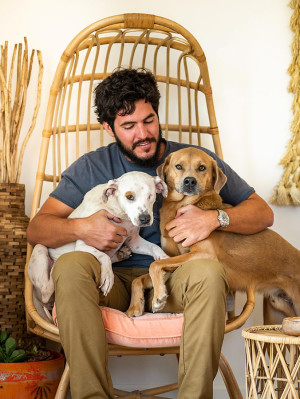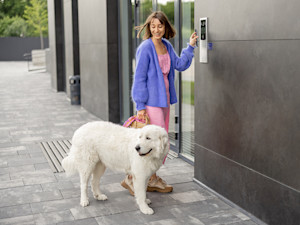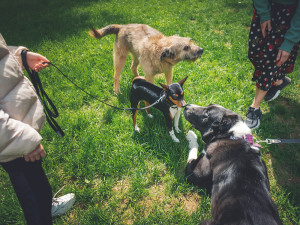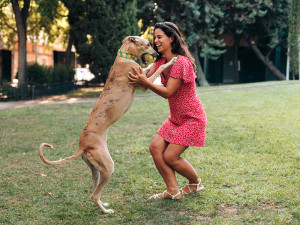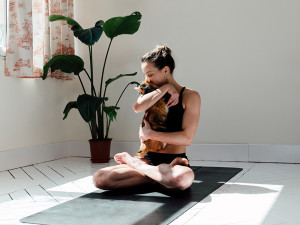Does Your Dog Know What the Heck an Elevator Is?
And how to help them feel less scared when they enter the tiny rumbling room that moves.

share article

Your pet wants you to read our newsletter. (Then give them a treat.)
Every day, at least three times a day, my dog, Cleo, and I take my building’s elevator down to the lobby so she can go on a walk. This means that every day, at least six times a day, I watch her happily sitting in the small, moving box and think, “What does she think is happening right now?”
What does a dog comprehend of a machine that uses an elaborate system of cables and counterweights to transport them and their humans from one floor to another? From Cleo’s perspective, she enters a small room that smells like strangers, the doors slide shut, everything shakes for a few seconds, and when the doors open again, the space outside the room is different than when she first entered it. Does she know we’re moving? If she knows we’re moving, does she know we’re going up and down? Does she believe she’s been teleported? Do I need to find more fulfillment and novelty in my life so I stop spending so much time wondering how my dog perceives the experience of riding an elevator?
Putting that last question aside for now, we can’t really know the answers to the others because, despite our best efforts to peer into dogs’ eyes and glean some understanding of what is doing on inside their soft, sweet heads, humans have completely yet to figure that out. But it’s still important to know how to make our pups’ lives as comfy for them as they can be — including when they walk inside a magical mechanical room.
So, how do dogs feel about elevators?
“It would be totally awesome to be able to put [our dogs] on the couch and say, ‘Hey, how’s this feeling for you? What’s your experience? What are you seeing?’” says Dr. Leslie Sinn, CPDT, DVM, a veterinarian and animal behaviorist in Ashburn, Virginia. “Unfortunately, we don’t have that degree of insight.”
I reached out to Dr. Sinn because I was curious about what was going on in Cleo’s head when we ride the elevator. My questions were broad and abstract: How do dogs perceive the world, and how do we interpret what they may or may not be perceiving? How accurate are our interpretations and how well do we really understand our beloved pups? But Dr. Sinn pointed out that for many dog owners, the question of what their dog is experiencing in an elevator is more than just a whimsical thought experiment. It’s a very real challenge. Many of her clients have dogs who struggle in elevators. To Dr. Sinn, this isn’t that surprising. If you’re a dog, she says, riding an elevator might feel something like an earthquake.
“They’re stepping on what is seemingly solid ground, and then all of a sudden the ground is moving,” she explains. “For many dogs, that’s a pretty terrifying experience unless it’s something that they’ve been introduced to early on.”
Bottom line: Elevators are scary.
Add to that the fact that elevators are often crammed with strangers, and you have the makings of an extremely stressful situation for a dog. When a dog feels uncomfortable, they can become scared, withdrawn, or, in some cases, reactive.
While we may not know what, exactly, a dog thinks is happening in an elevator, Dr. Sinn says we can easily tell whether a dog is comfortable or not. A comfortable dog will have loose, relaxed body language. They will willingly respond to cues and willingly eat treats if they are offered to them. They will happily hop on the elevator and won’t desperately drag you out as soon as the doors open. An uncomfortable dog, on the other hand, will have stiff, tense body language. They tremble, hunch in a corner, or plaster themselves to the sides of your legs for comfort. “Worst case scenario, they start to become reactive because they’re trying to create space around themselves,” Dr. Sinn cautions.
The best way to help a dog be comfortable in an elevator is to make sure they are exposed to the experience early on. But pet parents who have rescued adult dogs don’t have that option. In that case, Dr. Sinn says, there are a couple of ways to help. The first: Avoid the elevator altogether.
“What I tell a lot of people is, depending on how many floors they have to walk up and down, maybe instead of viewing it as an impediment, they can view it as an opportunity for more exercise,” Dr. Sinn adds, laughing.
Start small with the elevator.
But if the elevator is your only option for any reason, Dr. Sinn says the important thing when familiarizing your dog with the elevator is to start small. “You’ve got to back off a little bit and figure out ways to present it to them in small enough steps that they can handle it.”
Dr. Sinn recommends calling the elevator during a quiet time of the day when not too many people will be riding it, holding it on your floor for a few minutes, and asking your dog to step in and out of it. As the dog becomes more confident, you can take short trips — just one or two floors — and when they get off, play with them for a bit or give them a treat. “It starts being a positive experience and a happy thing, instead of something to be dreaded,” she says.
If your dog is reactive, Dr. Sinn said it’s important to avoid peak hours so as not to force them into situations where they’re scared. One point Dr. Sinn underscored, is that while many well-meaning pet parents have a tendency to force their dogs into a sort of DIY exposure therapy, and that’s not a helpful approach. In fact, it can often worsen the situation.
Be patient with your dog.
“The impression with these dogs is that, if you do it enough, then all will be will,” she says “But if they’re already worried about the situation, and you keep exposing them to it without changing anything, all it does is confirm their worst fears because every time they’re exposed to it, they’re scared to death.”
In the end, we may never know for sure what dogs think is happening in an elevator. And in fairness, even some humans who fully understand elevators absolutely hate riding them. Dr. Sinn encourages parents to be compassionate and patient with their pups.
“Try to see things through the dog’s eyes, right?” she advises. “Be aware, and realize that for a lot of them, it’s just not within their life experience. So be kind to them.”

Madeleine Aggeler
Madeleine Aggeler is a freelance journalist and copywriter in Washington, D.C. Previously, she was a writer at New York magazine’s The Cut. She lives with her dog, Cleo, who works primarily as a foot warmer.
Related articles
![Three dogs on leashes meeting and sniffing each other on a walk on the summer grass with owners]()
How Do I Get My Shy Dog To Socialize?
The Wildest Collective dog trainer Robert Haussmann’s tips for getting a shy pup to go from wallflower to social butterfly.
![Portrait of a woman playing and having fun in the park with her big pet, a greyhound dog.]() opens in a new tab
opens in a new tabHow’s Your Dog Feeling? Check Their Tail
If your dog’s tail is wagging “to the left, to the left,” as Beyoncé says, it could mean they’re anxious.
![Australian shephard and Corgi mix play fighting outside]() opens in a new tab
opens in a new tabTurns Out Humans Kind of Suck at Recognizing the Signs of Dog Aggression
A PSA to pay better attention to our best friends’ body language.
![Brown, half breed dog sitting on a chair next to his owner, a blonde stylish woman wearing a brown smart suit.]() opens in a new tab
opens in a new tabYour Dog Can Read Your Mind, Kind Of
Researchers say dogs actually have a pretty good sense of what we’re thinking.
![Illustration of a woman hugging a dog]() opens in a new tab
opens in a new tabIs That...Stress Your Dog Smells?
A 2022 study finds that your pup can tell — er, smell — when you’ve been doom-scrolling.
![A woman holding a cat close to her while sitting on a yoga mat.]() opens in a new tab
opens in a new tabShockingly, Your Pet Will Enhance Your Mindfulness Practice
The next time they try to kiss your face while you’re in corpse pose, let them.


